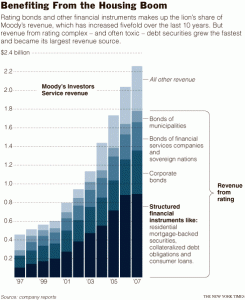“We obviously cannot ask payment for rating a bond. To do so would attach a price to the process, and we could not escape the charge, which would undoubtedly come, that our ratings are for sale.”
— Edmund Vogelius, a Moody’s vice president, explained the company’s business model in a 1957 article in The Christian Science Monitor
“These errors make us look either incompetent at credit analysis or like we sold our soul to the devil for revenue, or a little bit of both.”
— A Moody’s managing director responding anonymously to an internal management survey, September 2007.
>
The Sunday NYT has a big Gretchen Morgenson column on Moody’s, one of the three incompetent and corrupt ratings agencies that helped foster the current credit crisis.
 A combination of factors led the ratings agencies to their current state of criminal embarrassment. Once they went public, the usual short term focus on profits began driving what was once an objective decision making process regarding rating bonds.
A combination of factors led the ratings agencies to their current state of criminal embarrassment. Once they went public, the usual short term focus on profits began driving what was once an objective decision making process regarding rating bonds.
Once again, we see misplaced incentives shift the focus of a publicly traded firm: From safe, low-margin business of rating bonds to the more lucrative business of covering structured financial products and derivatives.
Thomas J. McGuire, a former director of corporate development at the company who left in 1996, was quote din the Times article, saying: “Moody’s was like a good watchdog that had regarded the financial markets as its turf and barked and growled when anybody it didn’t know came near it. But in the ’90s, that watchdog got muzzled and gelded. It was told to turn into a lapdog.”
This was a huge shift in where revenue came from. Formerly, it was the investors who bought Moody’s research and analysis. More recently, the ratings agencies worked with the underwriters. It was a bad case of pay-for-play payola, where triple AAA ratings weren’t forthcoming, the weasely bankers threatened to take their business to one of the other ratings firms.
And of course, the SEC, enraptured in their radical free-market, self-regulating, delusions, were nowhere to be found. The SEC is formerly in charge of supervising the agencies, but it was yet another example of nonfeasance: the intentional failure to perform a required legal duty or obligation.
Here’s an excerpt:
Since the subprime mortgage troubles exploded into a full-blown financial crisis last year, the three top credit-rating agencies — Moody’s, Standard & Poor’s and Fitch Ratings — have faced a firestorm of criticism about whether their rosy ratings of mortgage securities generated billions of dollars in losses to investors who relied on them.
The agencies are supposed to help investors evaluate the risk of what they are buying. But some former employees and many investors say the agencies, which were paid far more to rate complicated mortgage-related securities than to assess more traditional debt, either underestimated the risk of mortgage debt or simply overlooked its danger so they could rake in large profits during the housing boom.
A Moody’s spokesman, Anthony Mirenda, said the company would not change ratings without substantive reasons. “As a matter of policy, Moody’s is obligated to reconvene a rating committee if there is new information put forth by an issuer that could have a material impact on a security’s creditworthiness,” he said, “and our policies prohibit changes to ratings for anything other than credit considerations.”
He added that “Moody’s knows of no instances in which a reconvened rating committee resulted in improper changes to ratings on Countrywide securities.”
What a bunch of clowns.
Since I cannot put this in the book, I might as well toss it out here: All of these motherfuckers need to be thrown in prison, where they will be sodomized on a daily basis for the rest of their lives.
>
Previously:
Ratings Agencies 2007 = Equity Analysts 2000 ? (August 2007)
http://www.ritholtz.com/blog/2007/08/ratings-agencies-2007-equity-analysts-2000/
Source:
Debt Watchdogs: Tamed or Caught Napping?
GRETCHEN MORGENSON
Published: December 6, 2008
http://www.nytimes.com/2008/12/07/business/07rating.html
See Also:
Overrated
The subprime-mortgage meltdown could— finally—end the credit-ratings racket.
Jesse Eisinger
Portfolio, August 14, 2007 (September 2007 Print Issue)
http://www.portfolio.com/news-markets/national-news/portfolio/2007/08/13/Moody-Ratings-Fiasco
Wall Street often shelved damaging subprime reports
Patrick Rucker
Reuters, July 27, 2007
http://www.iht.com/articles/2007/08/01/bloomberg/sub.php
How Rating Firms’ Calls Fueled Subprime Mess
Benign View of Loans Helped Create Bonds, Led to More Lending
AARON LUCCHETTI and SERENA NG
WSJ, August 15, 2007; Page A1
http://online.wsj.com/article/SB118714461352698015.html


What's been said:
Discussions found on the web: